Finance: Master Budget Description, Issues, Importance & Starbucks
VerifiedAdded on 2023/04/20
|6
|1834
|384
Essay
AI Summary
This essay provides a comprehensive overview of the master budget, a critical management tool encompassing various operational budgets. It details the components of a master budget, including sales, production, and cash budgets, as well as budgeted financial statements. The essay also addresses common issues associated with master budgets, such as lack of specificity, difficulty in updating, and potential for unrealistic targets. Furthermore, it highlights the importance of master budgeting for planning, control, and coordination within organizations, and discusses how it drives continuous improvement. The essay concludes with a brief description of how Starbucks Corporation utilizes master budgeting, emphasizing the challenges of coordinating financial reports from various international trade centers and the company's use of a participative budgeting method.
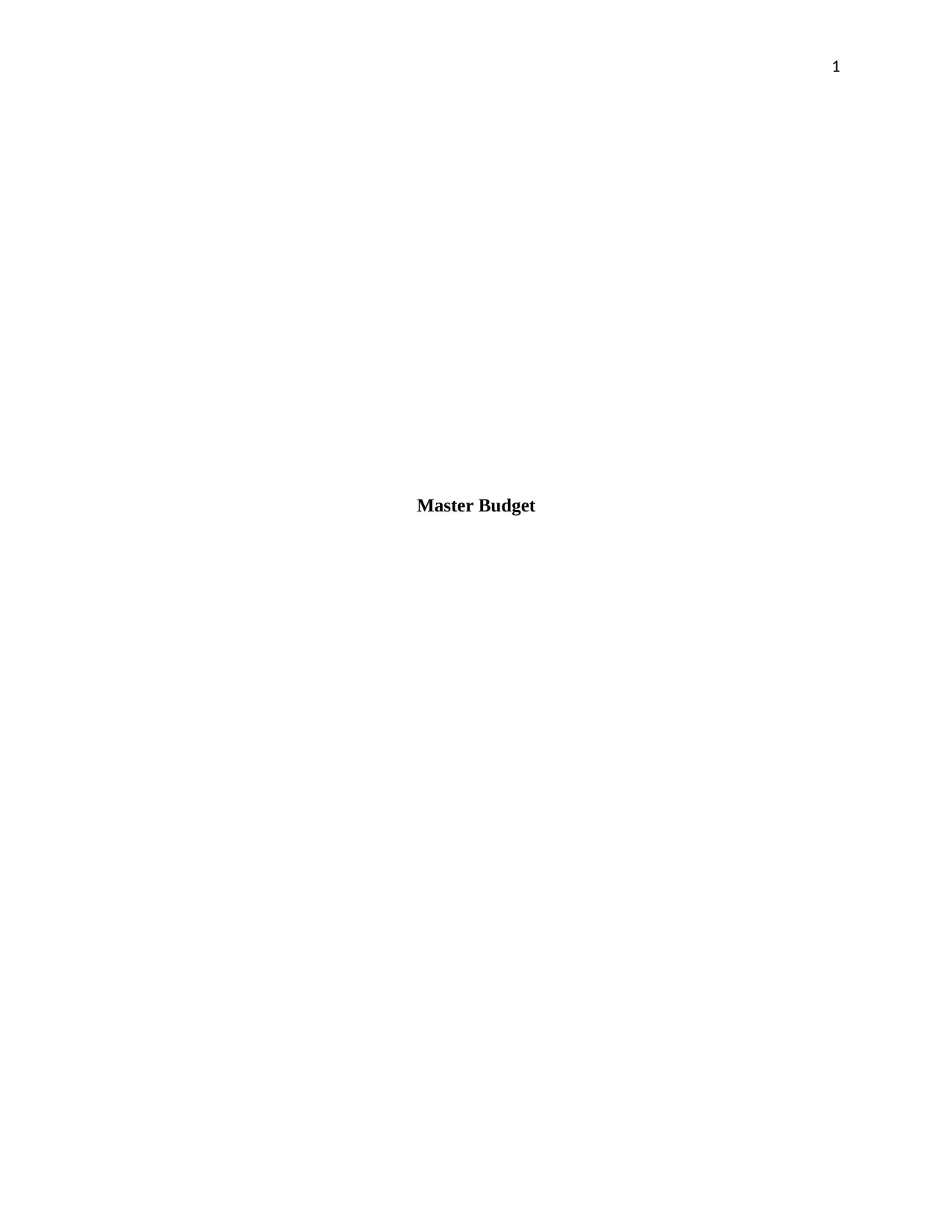
1
Master Budget
Master Budget
Paraphrase This Document
Need a fresh take? Get an instant paraphrase of this document with our AI Paraphraser
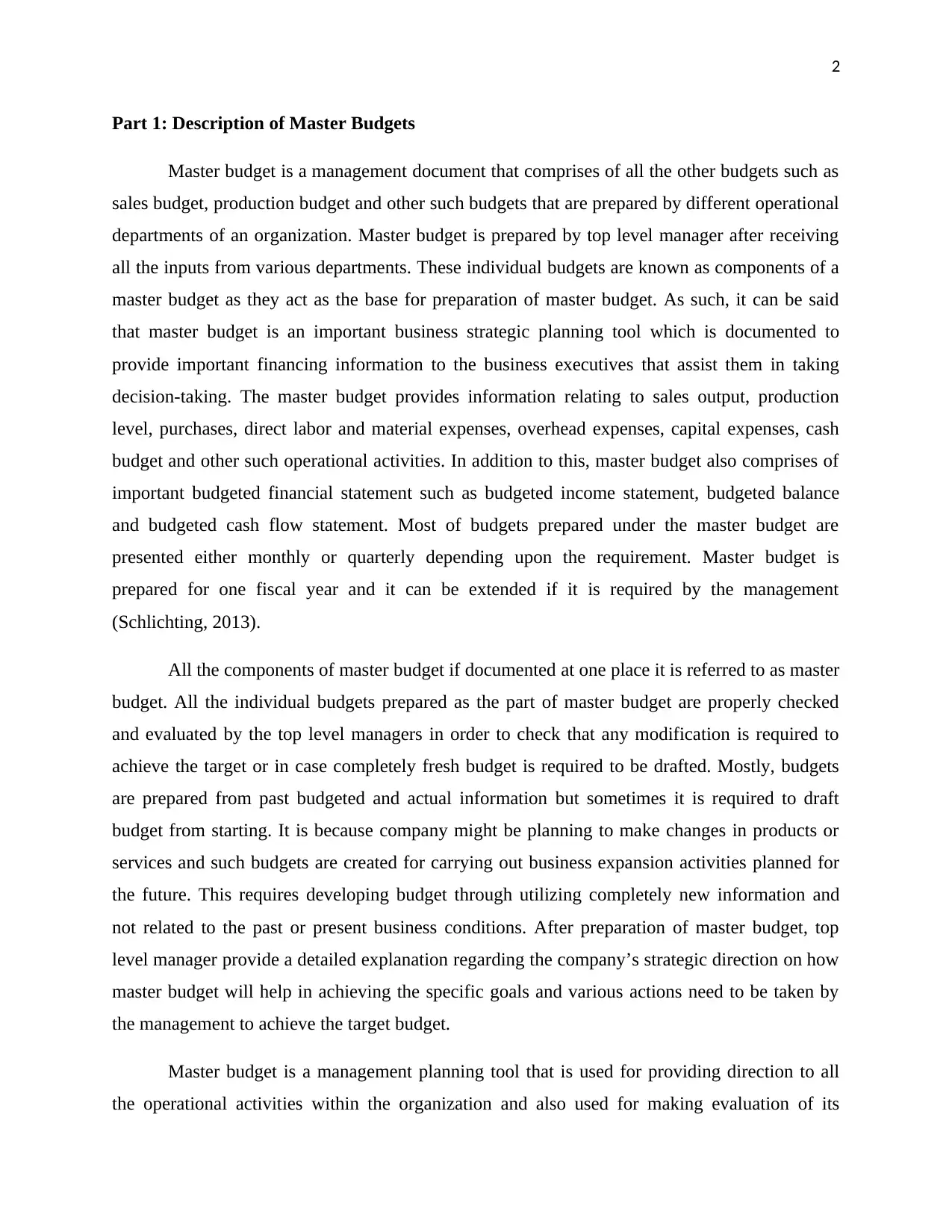
2
Part 1: Description of Master Budgets
Master budget is a management document that comprises of all the other budgets such as
sales budget, production budget and other such budgets that are prepared by different operational
departments of an organization. Master budget is prepared by top level manager after receiving
all the inputs from various departments. These individual budgets are known as components of a
master budget as they act as the base for preparation of master budget. As such, it can be said
that master budget is an important business strategic planning tool which is documented to
provide important financing information to the business executives that assist them in taking
decision-taking. The master budget provides information relating to sales output, production
level, purchases, direct labor and material expenses, overhead expenses, capital expenses, cash
budget and other such operational activities. In addition to this, master budget also comprises of
important budgeted financial statement such as budgeted income statement, budgeted balance
and budgeted cash flow statement. Most of budgets prepared under the master budget are
presented either monthly or quarterly depending upon the requirement. Master budget is
prepared for one fiscal year and it can be extended if it is required by the management
(Schlichting, 2013).
All the components of master budget if documented at one place it is referred to as master
budget. All the individual budgets prepared as the part of master budget are properly checked
and evaluated by the top level managers in order to check that any modification is required to
achieve the target or in case completely fresh budget is required to be drafted. Mostly, budgets
are prepared from past budgeted and actual information but sometimes it is required to draft
budget from starting. It is because company might be planning to make changes in products or
services and such budgets are created for carrying out business expansion activities planned for
the future. This requires developing budget through utilizing completely new information and
not related to the past or present business conditions. After preparation of master budget, top
level manager provide a detailed explanation regarding the company’s strategic direction on how
master budget will help in achieving the specific goals and various actions need to be taken by
the management to achieve the target budget.
Master budget is a management planning tool that is used for providing direction to all
the operational activities within the organization and also used for making evaluation of its
Part 1: Description of Master Budgets
Master budget is a management document that comprises of all the other budgets such as
sales budget, production budget and other such budgets that are prepared by different operational
departments of an organization. Master budget is prepared by top level manager after receiving
all the inputs from various departments. These individual budgets are known as components of a
master budget as they act as the base for preparation of master budget. As such, it can be said
that master budget is an important business strategic planning tool which is documented to
provide important financing information to the business executives that assist them in taking
decision-taking. The master budget provides information relating to sales output, production
level, purchases, direct labor and material expenses, overhead expenses, capital expenses, cash
budget and other such operational activities. In addition to this, master budget also comprises of
important budgeted financial statement such as budgeted income statement, budgeted balance
and budgeted cash flow statement. Most of budgets prepared under the master budget are
presented either monthly or quarterly depending upon the requirement. Master budget is
prepared for one fiscal year and it can be extended if it is required by the management
(Schlichting, 2013).
All the components of master budget if documented at one place it is referred to as master
budget. All the individual budgets prepared as the part of master budget are properly checked
and evaluated by the top level managers in order to check that any modification is required to
achieve the target or in case completely fresh budget is required to be drafted. Mostly, budgets
are prepared from past budgeted and actual information but sometimes it is required to draft
budget from starting. It is because company might be planning to make changes in products or
services and such budgets are created for carrying out business expansion activities planned for
the future. This requires developing budget through utilizing completely new information and
not related to the past or present business conditions. After preparation of master budget, top
level manager provide a detailed explanation regarding the company’s strategic direction on how
master budget will help in achieving the specific goals and various actions need to be taken by
the management to achieve the target budget.
Master budget is a management planning tool that is used for providing direction to all
the operational activities within the organization and also used for making evaluation of its
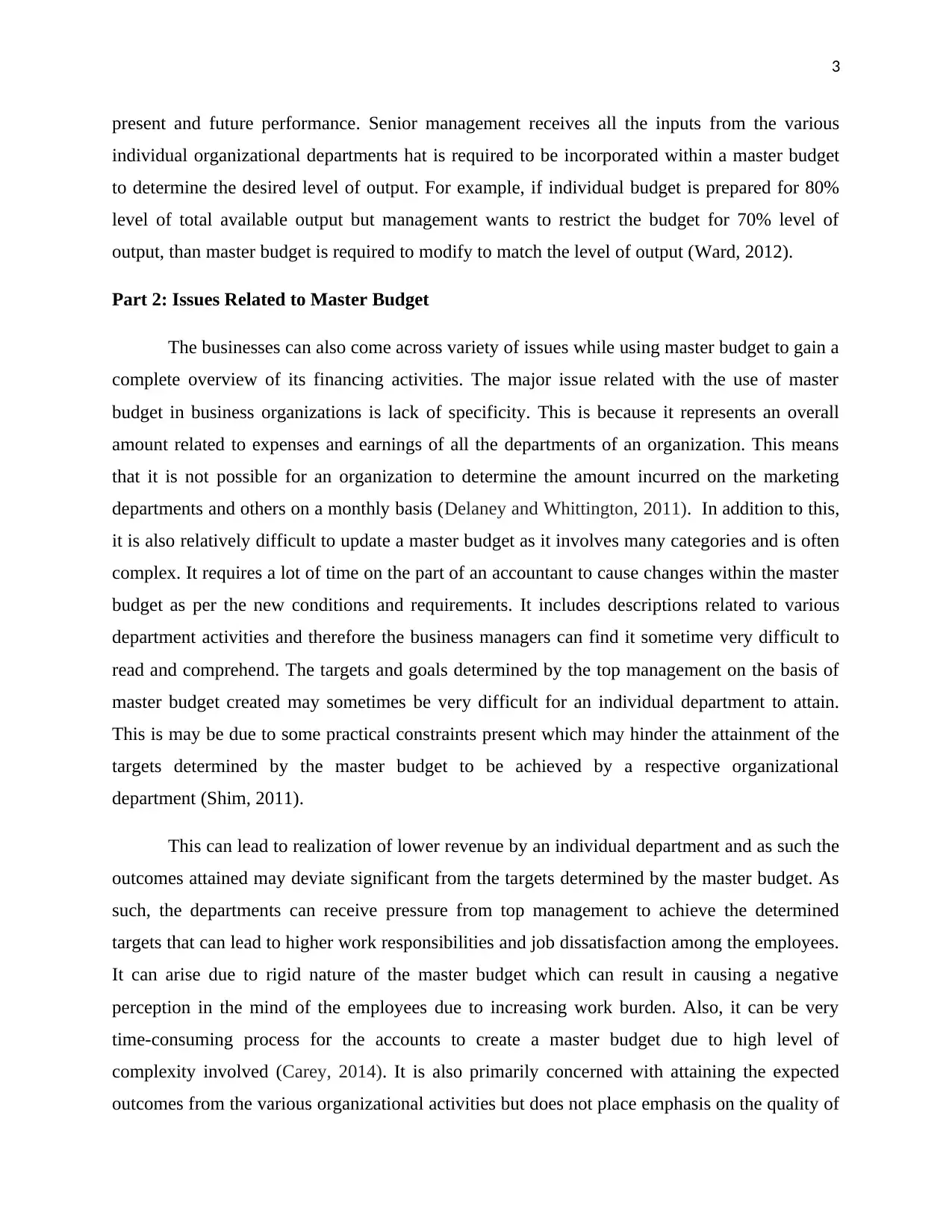
3
present and future performance. Senior management receives all the inputs from the various
individual organizational departments hat is required to be incorporated within a master budget
to determine the desired level of output. For example, if individual budget is prepared for 80%
level of total available output but management wants to restrict the budget for 70% level of
output, than master budget is required to modify to match the level of output (Ward, 2012).
Part 2: Issues Related to Master Budget
The businesses can also come across variety of issues while using master budget to gain a
complete overview of its financing activities. The major issue related with the use of master
budget in business organizations is lack of specificity. This is because it represents an overall
amount related to expenses and earnings of all the departments of an organization. This means
that it is not possible for an organization to determine the amount incurred on the marketing
departments and others on a monthly basis (Delaney and Whittington, 2011). In addition to this,
it is also relatively difficult to update a master budget as it involves many categories and is often
complex. It requires a lot of time on the part of an accountant to cause changes within the master
budget as per the new conditions and requirements. It includes descriptions related to various
department activities and therefore the business managers can find it sometime very difficult to
read and comprehend. The targets and goals determined by the top management on the basis of
master budget created may sometimes be very difficult for an individual department to attain.
This is may be due to some practical constraints present which may hinder the attainment of the
targets determined by the master budget to be achieved by a respective organizational
department (Shim, 2011).
This can lead to realization of lower revenue by an individual department and as such the
outcomes attained may deviate significant from the targets determined by the master budget. As
such, the departments can receive pressure from top management to achieve the determined
targets that can lead to higher work responsibilities and job dissatisfaction among the employees.
It can arise due to rigid nature of the master budget which can result in causing a negative
perception in the mind of the employees due to increasing work burden. Also, it can be very
time-consuming process for the accounts to create a master budget due to high level of
complexity involved (Carey, 2014). It is also primarily concerned with attaining the expected
outcomes from the various organizational activities but does not place emphasis on the quality of
present and future performance. Senior management receives all the inputs from the various
individual organizational departments hat is required to be incorporated within a master budget
to determine the desired level of output. For example, if individual budget is prepared for 80%
level of total available output but management wants to restrict the budget for 70% level of
output, than master budget is required to modify to match the level of output (Ward, 2012).
Part 2: Issues Related to Master Budget
The businesses can also come across variety of issues while using master budget to gain a
complete overview of its financing activities. The major issue related with the use of master
budget in business organizations is lack of specificity. This is because it represents an overall
amount related to expenses and earnings of all the departments of an organization. This means
that it is not possible for an organization to determine the amount incurred on the marketing
departments and others on a monthly basis (Delaney and Whittington, 2011). In addition to this,
it is also relatively difficult to update a master budget as it involves many categories and is often
complex. It requires a lot of time on the part of an accountant to cause changes within the master
budget as per the new conditions and requirements. It includes descriptions related to various
department activities and therefore the business managers can find it sometime very difficult to
read and comprehend. The targets and goals determined by the top management on the basis of
master budget created may sometimes be very difficult for an individual department to attain.
This is may be due to some practical constraints present which may hinder the attainment of the
targets determined by the master budget to be achieved by a respective organizational
department (Shim, 2011).
This can lead to realization of lower revenue by an individual department and as such the
outcomes attained may deviate significant from the targets determined by the master budget. As
such, the departments can receive pressure from top management to achieve the determined
targets that can lead to higher work responsibilities and job dissatisfaction among the employees.
It can arise due to rigid nature of the master budget which can result in causing a negative
perception in the mind of the employees due to increasing work burden. Also, it can be very
time-consuming process for the accounts to create a master budget due to high level of
complexity involved (Carey, 2014). It is also primarily concerned with attaining the expected
outcomes from the various organizational activities but does not place emphasis on the quality of
⊘ This is a preview!⊘
Do you want full access?
Subscribe today to unlock all pages.

Trusted by 1+ million students worldwide
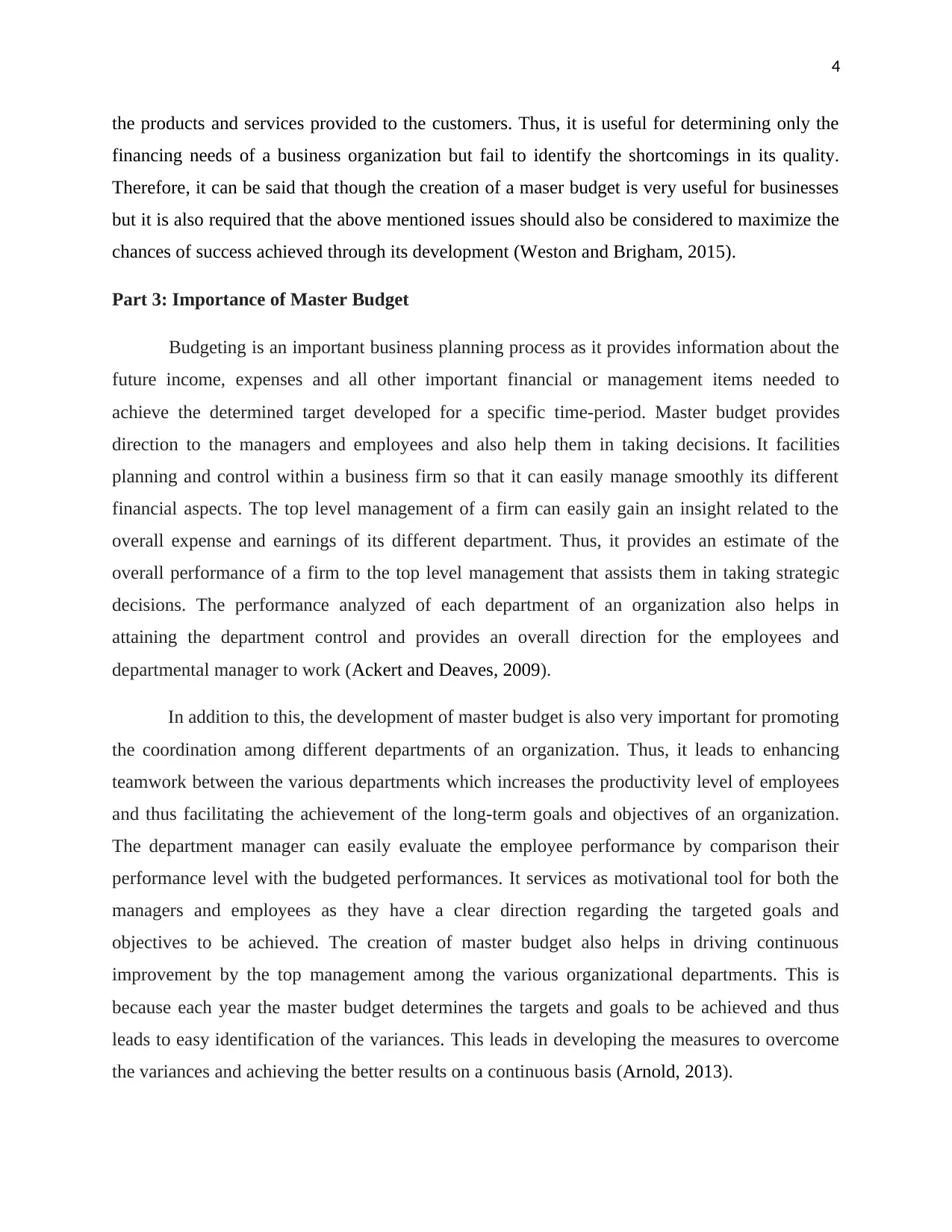
4
the products and services provided to the customers. Thus, it is useful for determining only the
financing needs of a business organization but fail to identify the shortcomings in its quality.
Therefore, it can be said that though the creation of a maser budget is very useful for businesses
but it is also required that the above mentioned issues should also be considered to maximize the
chances of success achieved through its development (Weston and Brigham, 2015).
Part 3: Importance of Master Budget
Budgeting is an important business planning process as it provides information about the
future income, expenses and all other important financial or management items needed to
achieve the determined target developed for a specific time-period. Master budget provides
direction to the managers and employees and also help them in taking decisions. It facilities
planning and control within a business firm so that it can easily manage smoothly its different
financial aspects. The top level management of a firm can easily gain an insight related to the
overall expense and earnings of its different department. Thus, it provides an estimate of the
overall performance of a firm to the top level management that assists them in taking strategic
decisions. The performance analyzed of each department of an organization also helps in
attaining the department control and provides an overall direction for the employees and
departmental manager to work (Ackert and Deaves, 2009).
In addition to this, the development of master budget is also very important for promoting
the coordination among different departments of an organization. Thus, it leads to enhancing
teamwork between the various departments which increases the productivity level of employees
and thus facilitating the achievement of the long-term goals and objectives of an organization.
The department manager can easily evaluate the employee performance by comparison their
performance level with the budgeted performances. It services as motivational tool for both the
managers and employees as they have a clear direction regarding the targeted goals and
objectives to be achieved. The creation of master budget also helps in driving continuous
improvement by the top management among the various organizational departments. This is
because each year the master budget determines the targets and goals to be achieved and thus
leads to easy identification of the variances. This leads in developing the measures to overcome
the variances and achieving the better results on a continuous basis (Arnold, 2013).
the products and services provided to the customers. Thus, it is useful for determining only the
financing needs of a business organization but fail to identify the shortcomings in its quality.
Therefore, it can be said that though the creation of a maser budget is very useful for businesses
but it is also required that the above mentioned issues should also be considered to maximize the
chances of success achieved through its development (Weston and Brigham, 2015).
Part 3: Importance of Master Budget
Budgeting is an important business planning process as it provides information about the
future income, expenses and all other important financial or management items needed to
achieve the determined target developed for a specific time-period. Master budget provides
direction to the managers and employees and also help them in taking decisions. It facilities
planning and control within a business firm so that it can easily manage smoothly its different
financial aspects. The top level management of a firm can easily gain an insight related to the
overall expense and earnings of its different department. Thus, it provides an estimate of the
overall performance of a firm to the top level management that assists them in taking strategic
decisions. The performance analyzed of each department of an organization also helps in
attaining the department control and provides an overall direction for the employees and
departmental manager to work (Ackert and Deaves, 2009).
In addition to this, the development of master budget is also very important for promoting
the coordination among different departments of an organization. Thus, it leads to enhancing
teamwork between the various departments which increases the productivity level of employees
and thus facilitating the achievement of the long-term goals and objectives of an organization.
The department manager can easily evaluate the employee performance by comparison their
performance level with the budgeted performances. It services as motivational tool for both the
managers and employees as they have a clear direction regarding the targeted goals and
objectives to be achieved. The creation of master budget also helps in driving continuous
improvement by the top management among the various organizational departments. This is
because each year the master budget determines the targets and goals to be achieved and thus
leads to easy identification of the variances. This leads in developing the measures to overcome
the variances and achieving the better results on a continuous basis (Arnold, 2013).
Paraphrase This Document
Need a fresh take? Get an instant paraphrase of this document with our AI Paraphraser
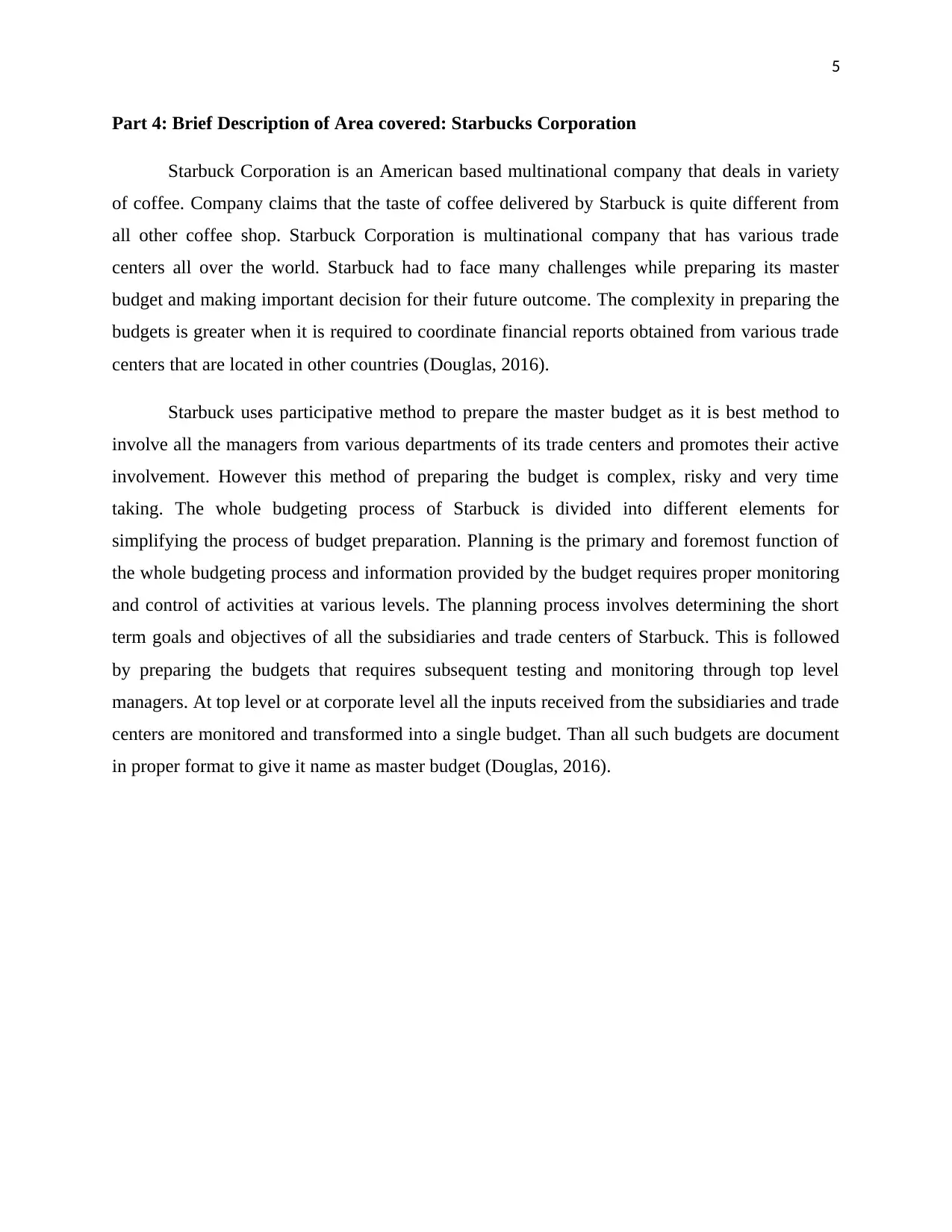
5
Part 4: Brief Description of Area covered: Starbucks Corporation
Starbuck Corporation is an American based multinational company that deals in variety
of coffee. Company claims that the taste of coffee delivered by Starbuck is quite different from
all other coffee shop. Starbuck Corporation is multinational company that has various trade
centers all over the world. Starbuck had to face many challenges while preparing its master
budget and making important decision for their future outcome. The complexity in preparing the
budgets is greater when it is required to coordinate financial reports obtained from various trade
centers that are located in other countries (Douglas, 2016).
Starbuck uses participative method to prepare the master budget as it is best method to
involve all the managers from various departments of its trade centers and promotes their active
involvement. However this method of preparing the budget is complex, risky and very time
taking. The whole budgeting process of Starbuck is divided into different elements for
simplifying the process of budget preparation. Planning is the primary and foremost function of
the whole budgeting process and information provided by the budget requires proper monitoring
and control of activities at various levels. The planning process involves determining the short
term goals and objectives of all the subsidiaries and trade centers of Starbuck. This is followed
by preparing the budgets that requires subsequent testing and monitoring through top level
managers. At top level or at corporate level all the inputs received from the subsidiaries and trade
centers are monitored and transformed into a single budget. Than all such budgets are document
in proper format to give it name as master budget (Douglas, 2016).
Part 4: Brief Description of Area covered: Starbucks Corporation
Starbuck Corporation is an American based multinational company that deals in variety
of coffee. Company claims that the taste of coffee delivered by Starbuck is quite different from
all other coffee shop. Starbuck Corporation is multinational company that has various trade
centers all over the world. Starbuck had to face many challenges while preparing its master
budget and making important decision for their future outcome. The complexity in preparing the
budgets is greater when it is required to coordinate financial reports obtained from various trade
centers that are located in other countries (Douglas, 2016).
Starbuck uses participative method to prepare the master budget as it is best method to
involve all the managers from various departments of its trade centers and promotes their active
involvement. However this method of preparing the budget is complex, risky and very time
taking. The whole budgeting process of Starbuck is divided into different elements for
simplifying the process of budget preparation. Planning is the primary and foremost function of
the whole budgeting process and information provided by the budget requires proper monitoring
and control of activities at various levels. The planning process involves determining the short
term goals and objectives of all the subsidiaries and trade centers of Starbuck. This is followed
by preparing the budgets that requires subsequent testing and monitoring through top level
managers. At top level or at corporate level all the inputs received from the subsidiaries and trade
centers are monitored and transformed into a single budget. Than all such budgets are document
in proper format to give it name as master budget (Douglas, 2016).
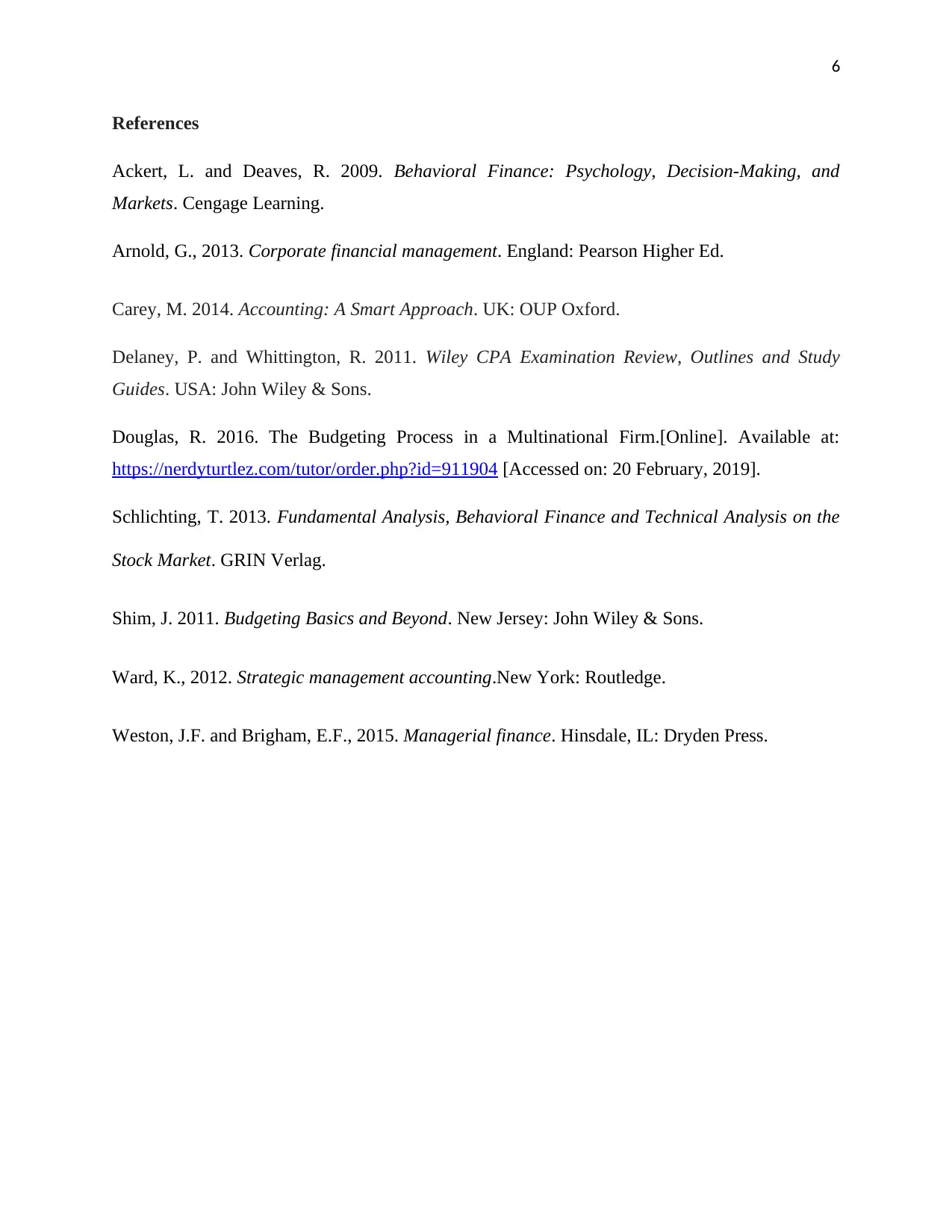
6
References
Ackert, L. and Deaves, R. 2009. Behavioral Finance: Psychology, Decision-Making, and
Markets. Cengage Learning.
Arnold, G., 2013. Corporate financial management. England: Pearson Higher Ed.
Carey, M. 2014. Accounting: A Smart Approach. UK: OUP Oxford.
Delaney, P. and Whittington, R. 2011. Wiley CPA Examination Review, Outlines and Study
Guides. USA: John Wiley & Sons.
Douglas, R. 2016. The Budgeting Process in a Multinational Firm.[Online]. Available at:
https://nerdyturtlez.com/tutor/order.php?id=911904 [Accessed on: 20 February, 2019].
Schlichting, T. 2013. Fundamental Analysis, Behavioral Finance and Technical Analysis on the
Stock Market. GRIN Verlag.
Shim, J. 2011. Budgeting Basics and Beyond. New Jersey: John Wiley & Sons.
Ward, K., 2012. Strategic management accounting.New York: Routledge.
Weston, J.F. and Brigham, E.F., 2015. Managerial finance. Hinsdale, IL: Dryden Press.
References
Ackert, L. and Deaves, R. 2009. Behavioral Finance: Psychology, Decision-Making, and
Markets. Cengage Learning.
Arnold, G., 2013. Corporate financial management. England: Pearson Higher Ed.
Carey, M. 2014. Accounting: A Smart Approach. UK: OUP Oxford.
Delaney, P. and Whittington, R. 2011. Wiley CPA Examination Review, Outlines and Study
Guides. USA: John Wiley & Sons.
Douglas, R. 2016. The Budgeting Process in a Multinational Firm.[Online]. Available at:
https://nerdyturtlez.com/tutor/order.php?id=911904 [Accessed on: 20 February, 2019].
Schlichting, T. 2013. Fundamental Analysis, Behavioral Finance and Technical Analysis on the
Stock Market. GRIN Verlag.
Shim, J. 2011. Budgeting Basics and Beyond. New Jersey: John Wiley & Sons.
Ward, K., 2012. Strategic management accounting.New York: Routledge.
Weston, J.F. and Brigham, E.F., 2015. Managerial finance. Hinsdale, IL: Dryden Press.
⊘ This is a preview!⊘
Do you want full access?
Subscribe today to unlock all pages.

Trusted by 1+ million students worldwide
1 out of 6
Related Documents
Your All-in-One AI-Powered Toolkit for Academic Success.
+13062052269
info@desklib.com
Available 24*7 on WhatsApp / Email
![[object Object]](/_next/static/media/star-bottom.7253800d.svg)
Unlock your academic potential
Copyright © 2020–2025 A2Z Services. All Rights Reserved. Developed and managed by ZUCOL.





